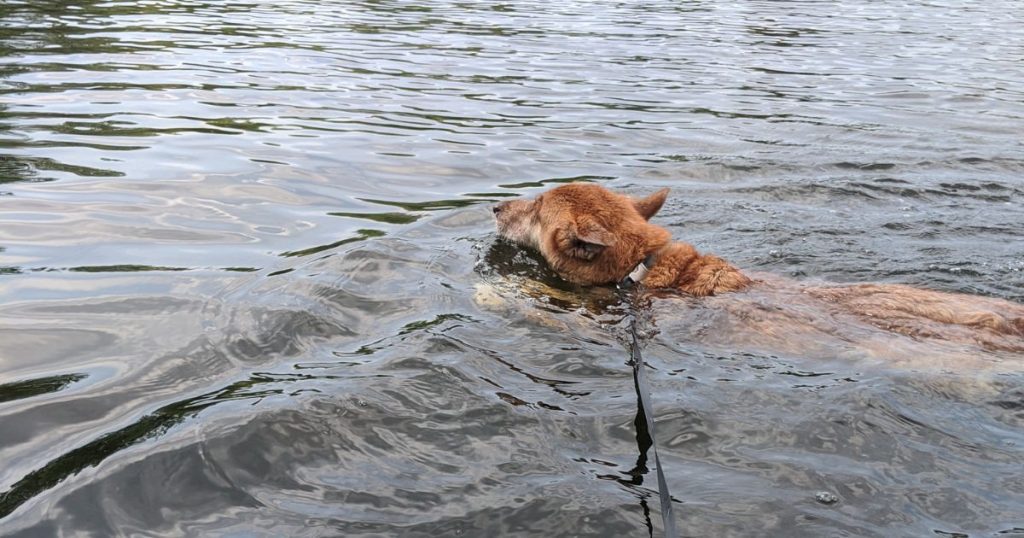How Do I Teach My Dog to Swim?
Are you a beach lover or canoe enthusiast and want to bring your dog with you on your next water adventure? If so, you may find yourself asking – Can I teach my dog to swim? Better yet, you may be wondering if you even need to teach your dog to swim. After all, some breeds were bred to be on the water. Right?
There are many great dog-friendly beaches and lakes for dogs to swim in. But first, you need to make sure that your dog is comfortable enough to go swimming safely. To help you prepare properly and ensure a comfortable and enjoyable day in the water for everyone involved (including your dog), we’ve put together this quick guide to swimming for dogs.

This post contains affiliate links, which means if you click and buy, we will make a commission (at no cost to you). See my full disclosure policy for more details.
Do Dogs Need to be Taught to Swim?
Whether you need to teach your dog to swim, and how much teaching is needed, will depend on a few factors. Some dogs are reluctant to even step foot in the water at first while others will barrel in with no hesitation.
If you’ve recently adopted a breed that was bred to perform in the water like a Flat-Coated Retriever or a Nova Scotia Duck Tolling Retriever you may assume that your dog will instantly take to the water. But this isn’t always the truth. Our boy Indiana is a Flat-Coated Retriever mix and has no interest in water outside of walking around and getting his feet wet, and even that took training and a gradual introduction.
Even dogs that are natural-born swimmers often need to learn a little. This can take them from splashing around to a more refined and confident way of swimming in the water.
What Age Can Dogs Learn to Swim?
If you have recently adopted an older dog or are considering introducing your dog to water for the first time, don’t worry! Dogs can learn to swim at any age. The ideal age to teach a dog to swim if you are setting them up for a full life in the water is the young age of ten weeks. At that age, your dog is starting to build the strength and endurance that will be needed to start.
Of course, as we previously mentioned, you can train your dog to swim at any age. The way that you introduce your dog to water and teach your dog to swim is the most important factor in his success.

What Breeds of Dog Can’t Swim? Why?
There are a few dog breeds that face unique challenges when it comes to learning to swim. Due to the shape of their body or the structure of their face, it’s difficult to keep themselves afloat. Some of these dogs will still enjoy being around water, but they are most comfortable walking around in the shallow water with their feet safely on the ground.
Some dogs that can’t swim as easily (or at all) include:
Brachycephalic Breeds
With their short snouts and flat faces, these dogs struggle with a lot of physical activity. Their face structure makes it harder to breathe. But it also makes it easier to get water up their noses which can contribute to drowning. Examples include Bulldogs, Pugs, and Boxers, among others.
Long Bodies and Short Legs
The first breed that comes to mind when reading that description is the Dachshund. This isn’t to say that they can’t swim, but their short legs must work even harder to keep them afloat which can make it an exhausting experience. You can teach your Dachshund to swim, but many simply aren’t interested in water activities – and that’s okay! In addition to the Dachshund, this includes Corgis and Basset Hounds.
Dogs with Long Coats
This isn’t to say that dogs with long coats can’t swim, but it may be a little more difficult for them to get used to. Much like women who are dragged down by the weight of a wet dress during photo shoots, their fur makes it harder to stay above the water. Examples include the Afghan Hound, Puli, and Komondor.
Is Swimming a Good Exercise for Dogs?
Not only is swimming good exercise for dogs, but it offers some great health benefits both mentally and physically. Swimming in warm water is often incorporated into rehabilitation efforts for dogs to help strengthen joints, build muscles, and improve circulation. It’s a low-impact exercise for dogs with arthritis and other joint problems. It’s also a great way for overweight dogs to burn calories without putting too much stress on their bodies.
It’s also a great opportunity for your dog to cool off on a hot summer day.
For dogs that are highly stressed or anxious (in general, not in terms of water), swimming can help to improve their mental health. Exercise is a great way to reduce stress and release any pent-up energy. As the old saying goes, a tired dog is a happy dog!

Is Too Much Swimming Bad for Dogs?
Swimming, for dogs, is a fun and entertaining experience. But, as with anything, there can be too much of a good thing. By limiting your dog’s access to bodies of water, you can allow him to enjoy himself swimming while reducing the chance of accidents or injuries.
Exhaustion Can Increase Drowning Risks
If your dog truly loves water and wants to spend all his time playing in the water, you may need to force breaks and rest time. Getting caught up in the excitement of the moment, some dogs will push themselves right to the brink of exhaustion. This is a lesson we have learned when it comes to our girl Daviana. If we don’t pull her out of the water, we will literally see her start slowing down from being so tired and still heading out to swim some more.
Like humans, as your dog starts to feel tired and worn out, the same can be said for your dog. If he runs into a heavy current or undertow, he may not have the strength to fight his way free.
Water Intoxication
Another serious risk for dogs when playing in the water is water intoxication or hyponatremia. This occurs when a dog ingests too much water too quickly. As a result, the cells in the body fill with water and swell, the brain swells, and the body’s sodium levels drop. It can quickly turn fatal if not addressed.
Few, if any, dogs will physically drink enough to trigger water intoxication unless there is an underlying health condition causing extreme thirst. However, they often ingest water while diving into bodies of water or retrieving toys from the water. This means that playing fetch in the water for too long could have some serious consequences.
The common warning signs of water intoxication include:
- Vomiting
- Bloating
- Excess Salivation
- Glazed Eyes
- Lethargy
- Loss of Coordination
- Difficulty Breathing
- Seizures
- Coma
If you notice any combination of these signs or have reason to believe that your dog may be suffering from water intoxication, contact your veterinarian immediately.
Swimmer’s Tail
This condition is most common in larger breeds, including hunting and working dogs. When a dog has been swimming for an extended period of time, it may strain the muscles in their tail from overuse. This leads to the trail going limp, drooping between the dog’s legs. It can be completely limp or, you may see limpness only at the end of the tail. It’s also known as dead tail, limber tail, cold water tail, broken wag, and sprained tail.
Swimmer’s tail can be painful and uncomfortable for your dog. As a result, you may notice him pacing, yelping when sitting or lying down, or looking uncomfortable while going to the bathroom. He may also try chewing at his tail to address the pain or struggle to stand up due to loss of balance.
Treatment for swimmer’s tail is rest and recovery. To help keep your dog comfortable and address the short-term side effects, your veterinarian may prescribe anti-inflammatory drugs to reduce the swelling. Most dogs will recover within 2 to 14 days.

How Do I Teach My Dog to Swim?
Are you ready to teach your dog to swim? With the addition of Lucifer to our family, this is a process that we have been working through recently. He was excited about smaller kiddie pools and even got into the tub willingly but anything with waves was stressful. On our recent trip, he’s finally overcome this to enjoy swimming with our older two (and boy was he proud of himself).
Here are the steps that we follow to teach each of our dogs to swim.
Keep in mind that every dog is different. While some dogs may need to work through these steps slower with extra reinforcement, others may power through them as if they have been swimming all their lives. The most important thing to remember when you set out to teach a dog to swim is to let him decide how quickly you progress.
If you are concerned about your dog’s safety while working through this process, you may also want to have him wear a dog life jacket for added security until he is a confident swimmer.
Step 1: Introduce Your Dog to Water
The first step for many dogs is for your dog to simply be comfortable in the water. The way to go about this will depend on how they naturally feel getting their feet wet. For many, you can begin by simply walking in the edge of the lake or river that you plan on letting your dog swim in. But some dogs may need to start with a little water in a tub or kiddie pool at home.
At this stage, the only part of your dog that should be getting wet is his paws. Let him walk around, explore, and get comfortable with the experience.
A few things that could trigger anxiety in dogs that are unsure of water include:
- The feel of water
- Splashing
- Waves
- Cold shock on entry
- Slippery/unsure footing
You can help to take their mind off the things that make them uneasy and make the experience a positive one by incorporating treats, praise, or your dog’s favourite toys. Lucifer loves a game of fetch, so we tossed a ball around the shallow edge of the lake until he completely forgot that the waves that made him nervous even existed.
Step 2: Enter Deeper Water Together
When your dog is comfortable in shallow water, it’s time to move to slightly deeper water. The most important point to remember in this step is that you need to be by your dog’s side throughout this process. Having his person with him will provide a much-needed sense of security if he gets scared.
The goal is to slowly encourage him to go deeper and deeper until he is deep enough that he needs to paddle to keep himself afloat. Many dogs will try paddling only with their front feet at first. To encourage your dog to engage all four legs, try holding them up around the belly in deeper water to allow them to paddle with less stress and without the temptation to put their back feet down to seek ground.

Step 3: Encourage Your Dog to Swim Alone
Is your dog comfortable paddling in the water with you next to him? If so, it may be time for him to try swimming on his own. At this step, we put our dogs on a long lead and moved out into the water deep enough that the dog will have to paddle. We then called the dog, encouraging him to come out to us.
They usually walk the beginning confidently, with no hesitation. After all, they are now comfortable in the water and have secure footing. The challenge comes when they must enter the deeper water on their own to get to their person.
When your dog does make his way out to you, don’t hesitate to support him for a break. An arm under his belly can give him the support he needs to take a breath before heading back to shallower waters. Make sure that you are getting him lots of praise to encourage him to do this again in the future.
Another way to encourage your dog to swim alone is to throw a toy out into the water for him to go fetch. Lucifer’s favourite fetch ball is his Chuckit! Max Glow Ball. Daviana, meanwhile, loves her KONG Squeezz Ball. Have fun with the process of finding your dog’s go-to fetch toy.

Is your dog a water-loving dog? Was he always this way, or did you have to teach your dog to swim? We’d love to hear your water dog stories in the comments!

